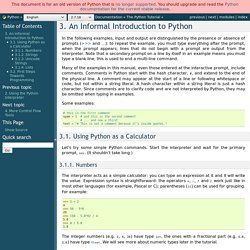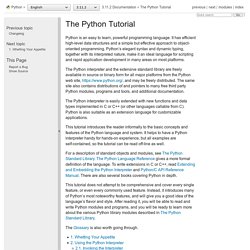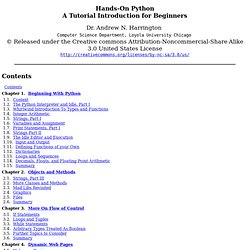

Learning Python: Powerful Object-Oriented Programming: Mark Lutz: 9780596158064: Amazon.com. Python Pocket Reference: Python in Your Pocket (Pocket Reference (O'Reilly)): Mark Lutz: 9780596158088: Amazon.com. Think Python: How to Think Like a Computer Scientist. How to Think Like a Computer Scientist.

An Introduction to Python: Guido van Rossum, Jr. Fred L. Drake: 9780954161767: Amazon.com. IronPython in Action: Michael J. Foord, Christian Muirhead: 9781933988337: Amazon.com. The Python Tutorial. Python is an easy to learn, powerful programming language.

It has efficient high-level data structures and a simple but effective approach to object-oriented programming. Python’s elegant syntax and dynamic typing, together with its interpreted nature, make it an ideal language for scripting and rapid application development in many areas on most platforms. The Python interpreter and the extensive standard library are freely available in source or binary form for all major platforms from the Python Web site, and may be freely distributed.
The same site also contains distributions of and pointers to many free third party Python modules, programs and tools, and additional documentation. The Python interpreter is easily extended with new functions and data types implemented in C or C++ (or other languages callable from C). This tutorial introduces the reader informally to the basic concepts and features of the Python language and system. The Glossary is also worth going through. Learn Python The Hard Way, 2nd Edition — Learn Python The Hard Way, 2nd Edition. 3. An Informal Introduction to Python. In the following examples, input and output are distinguished by the presence or absence of prompts (>>> and ...): to repeat the example, you must type everything after the prompt, when the prompt appears; lines that do not begin with a prompt are output from the interpreter.

Note that a secondary prompt on a line by itself in an example means you must type a blank line; this is used to end a multi-line command. Many of the examples in this manual, even those entered at the interactive prompt, include comments. Comments in Python start with the hash character, #, and extend to the end of the physical line. A comment may appear at the start of a line or following whitespace or code, but not within a string literal. A hash character within a string literal is just a hash character. Let’s try some simple Python commands. 3.1.1. The interpreter acts as a simple calculator: you can type an expression at it and it will write the value.
>>> width = 20>>> height = 5 * 9>>> width * height900. The Python Language Reference — Python v3.3.0 documentation. The Python Tutorial — Python v3.3.0 documentation. Python is an easy to learn, powerful programming language.

It has efficient high-level data structures and a simple but effective approach to object-oriented programming. Python’s elegant syntax and dynamic typing, together with its interpreted nature, make it an ideal language for scripting and rapid application development in many areas on most platforms. The Python interpreter and the extensive standard library are freely available in source or binary form for all major platforms from the Python web site, and may be freely distributed.
The same site also contains distributions of and pointers to many free third party Python modules, programs and tools, and additional documentation. The Python interpreter is easily extended with new functions and data types implemented in C or C++ (or other languages callable from C). This tutorial introduces the reader informally to the basic concepts and features of the Python language and system. The Glossary is also worth going through.
The Python Tutorial — Python v3.3.0 documentation. Python is an easy to learn, powerful programming language. It has efficient high-level data structures and a simple but effective approach to object-oriented programming. Python’s elegant syntax and dynamic typing, together with its interpreted nature, make it an ideal language for scripting and rapid application development in many areas on most platforms. The Python interpreter and the extensive standard library are freely available in source or binary form for all major platforms from the Python web site, and may be freely distributed. Think Python. Hands-On Python A Tutorial Introduction for Beginners. Hands-On Python A Tutorial Introduction for Beginners Contents Chapter 1Beginning With Python 1.1.

Context You have probably used computers to do all sorts of useful and interesting things. How to Think Like a Computer Scientist — How to Think Like a Computer Scientist: Learning with Python v2nd Edition documentation. Navigation How to Think Like a Computer Scientist¶ Learning with Python¶ 2nd Edition (Using Python 2.x) by Jeffrey Elkner, Allen B.

Downey, and Chris Meyers Last Updated: 21 April 2012 Copyright NoticeForewordPrefaceContributor ListChapter 1 The way of the programChapter 2 Variables, expressions, and statementsChapter 3 FunctionsChapter 4 ConditionalsChapter 5 Fruitful functionsChapter 6 IterationChapter 7 StringsChapter 8 Case Study: CatchChapter 9 ListsChapter 10 Modules and filesChapter 11 Recursion and exceptionsChapter 12 DictionariesChapter 13 Classes and objectsChapter 14 Classes and functionsChapter 15 Classes and methodsChapter 16 Sets of ObjectsChapter 17 InheritanceChapter 18 Linked ListsChapter 19 StacksChapter 20 QueuesChapter 21 TreesAppendix A DebuggingAppendix B GASPAppendix c Configuring Ubuntu for Python DevelopmentAppendix D Customizing and Contributing to the BookGNU Free Document License Search Page © Copyright 2010, Jeffrey Elkner, Allen B.